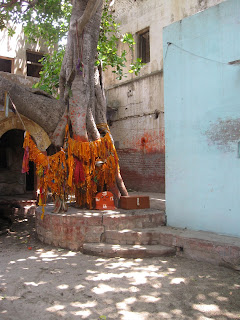One long day visit of 19 hours from Faridabad to Mathura, Gokul, Brindawan, Fateshpur Sikri, Taj Mahal was done by car on very hot day. The travel was smooth except that their was some fear after 8 pm. Although the driver was local and known to the route, there were hardly any car on the road or petrol pump.
Krishna_Janmasthan_Temple_Complex is a group of Hindu temples in Mathura. These temples are built around the place where major Hindu deity Krishna is said to have been born. The temples were destroyed multiple times throughout history, latest by Mughal emperor Aurangzeb in 1670 who erected Eidgah there. In 20th century, the new temple complex was built with the financial help from industrialists containing the Keshavdeva temple, the Garbha Griha temple at the birth place and the Bhagavata Bhavan.
Gokul where Krishna spent his child hood. The nand mahal aroused the memories of Krishna Showing universe to Yashoda in his mouth, the place where Putana was killed.
Buland_Darwaza, Fateshpur Sikri बुलंद दरवाज़ा or the "Gate of victory", was built in 1601 A.D. by Mughal emperor Akbar to commemorate his victory over Gujarat. It is the main entrance to the palace. Buland Darwaza is the highest gateway in the world and is an example of Mughal architecture. The Bulund Darwaza has been designated as a UNESCO World Heritage Site
Taj Mahal, Agra is an ivory-white marble mausoleum on the south bank of the Yamuna river in the Indian city of Agra. It was commissioned in 1632 by the Mughal emperor Shah Jahan to house the tomb of his favourite wife, Mumtaz Mahal. The tomb is the centre piece of a 17-hectare (42-acre) complex, which includes a mosque and a guest house, and is set in formal gardens bounded on three sides by a crenellated wall.
The Taj Mahal complex is believed to have been completed in its entirety in 1653 at a cost estimated at the time to be around 32 million rupees, The construction project employed some 20,000 artisans under the guidance of a board of architects led by the court architect to the emperor, Ustad Ahmad Lahauri.
The Taj Mahal has been designated as a UNESCO World Heritage Site in 1983 for being "the jewel of Muslim Art in India and one of the universally admired masterpieces of the world's heritage". The Taj Mahal attracts 7–8 million visitors a year and in 2007, it was declared a winner of the New7Wonders of the World (2000–2007) initiative.
 |
| Photo Gimmick |
 |
| Gloomy Sunset Moment from the Taj Mahal |












































No comments:
Post a Comment